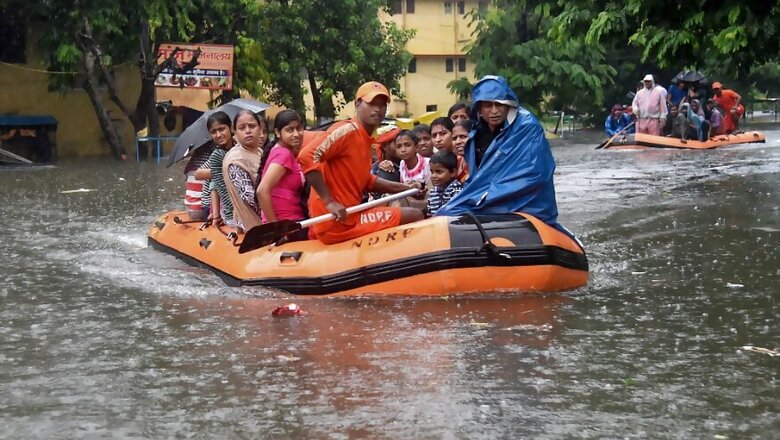
views
New Delhi: The Met Department has said that the next 24 hours may bring more rainfall in Bihar, which has already suffered the loss of 110 lives in pounding by torrential rains over the past few days. Patna remains the worst-affected in the state, with authorities shutting down schools till Tuesday.
Bihar CM Nitish Kumar said even the weather department was “clueless”. “It is nature's fury before which man is often helpless. We are, however, trying our best. The problem is we have no idea how long the downpour which caps a prolonged dry spell causing a drought-like situation is going to last. Even the weather department seems clueless, making different predictions at different points of time,” he said.
But why is the rainfall so severe and how much of the floods are actually due to climate change? News18 explains:
Why are there such heavy rains in Bihar?
There are two weather systems at work here - a cyclonic circulation over south-eastern Uttar Pradesh and its adjoining areas and a trough (an elongated area of relatively low atmospheric pressure) that extends from Punjab to south Assam.
“Bihar experienced widespread rainfall with ‘heavy’ to ‘very heavy’ rainfall in isolated places for three consecutive days. Intensity and distribution of rainfall over Bihar are very likely to reduce from September 30,” the IMD said on Monday.
The IMD’s Patna centre noted on Sunday evening that the cyclonic circulation persisted, as did the trough. Rainfall and thunderstorms were likely in all districts of the state.
How unusual is this?
Officially, the four-month monsoon season was to end on Monday, but its actual withdrawal is likely to be in the coming week. IMD officials maintained that this could be the most delayed withdrawal since 1960. For instance, Rajasthan, where the monsoon normally retreats starting from its western areas from September 1, saw rainfall till late in the month.
Officials said that the withdrawal of monsoon from west Rajasthan would only start during the second week of October, with the likelihood of increased rainfall in the region in the first week of October.
The Met Department, in its forecast on Monday morning, predicted heavy rainfall in Bihar, eastern Uttar Pradesh and Bengal on Monday, while heavy to very heavy rainfall was predicted “at isolated places over east Rajasthan, west Madhya Pradesh, and Assam & Meghalaya” along with heavy rainfall “at isolated places over Sub-Himalayan West Bengal & Sikkim, and Nagaland, Manipur, Mizoram & Tripura, Gujarat, Maharashtra, Tamil Nadu, Puducherry & Karaikal and Kerala & Mahe.”
Are the rains linked to climate change?
Scientists point out that extreme rainfall events are on the rise in the country, as are longer dry spells with more intense rainfall concentrated in just a few days.
A 2017 study by researchers at the Indian Institute of Tropical Meteorology said there was a “threefold increase in widespread extreme rain events over central India during 1950–2015” and that this was due to the “increasing variability of the low-level monsoon westerlies over the Arabian Sea, driving surges of moisture supply, leading to extreme rainfall episodes across the entire central subcontinent.”
As of September 30, the average rainfall received in the month was at 247.1 mm — 48 per cent above the normal, and, as per a Times of India report, the third-highest in the IMD’s records since 1901.
With rainfall lashing Bihar and Gujarat, this is on track to becoming the highest rainfall for the month of September since 1901. The report added that the all-India average seasonal rainfall stands at 956.1mm, 9 per cent higher than the normal of 877mm till Sunday. As per the IMD, the annual mean temperature in the country increased by 0.6 degrees between 1901 and 2018, when compared to pre-industrial levels. Of the 15 warmest years, 11 have been in the last 15.
This has already begun having an impact on food security, and it is only likely to get worse, experts predict. A recent IPCC report also warned that in the upcoming decades, food security will be threatened due to climate change, along with the demands of a larger population.
What makes Bihar especially vulnerable?
Bihar is among the most climate-sensitive states in India, not just due to its geographical setting and related meteorological uncertainties, but also the dense population.
Agriculture accounts for nearly 22 per cent of its GDP and is the source of livelihood for nearly 90 per cent of its population. With droughts and extreme-rainfall events becoming increasingly common, the population remains extremely vulnerable. The state government has noted this and is attempting to transform its agriculture and its allied sectors into climate-resilient systems to ensure sustained food security.



















Comments
0 comment